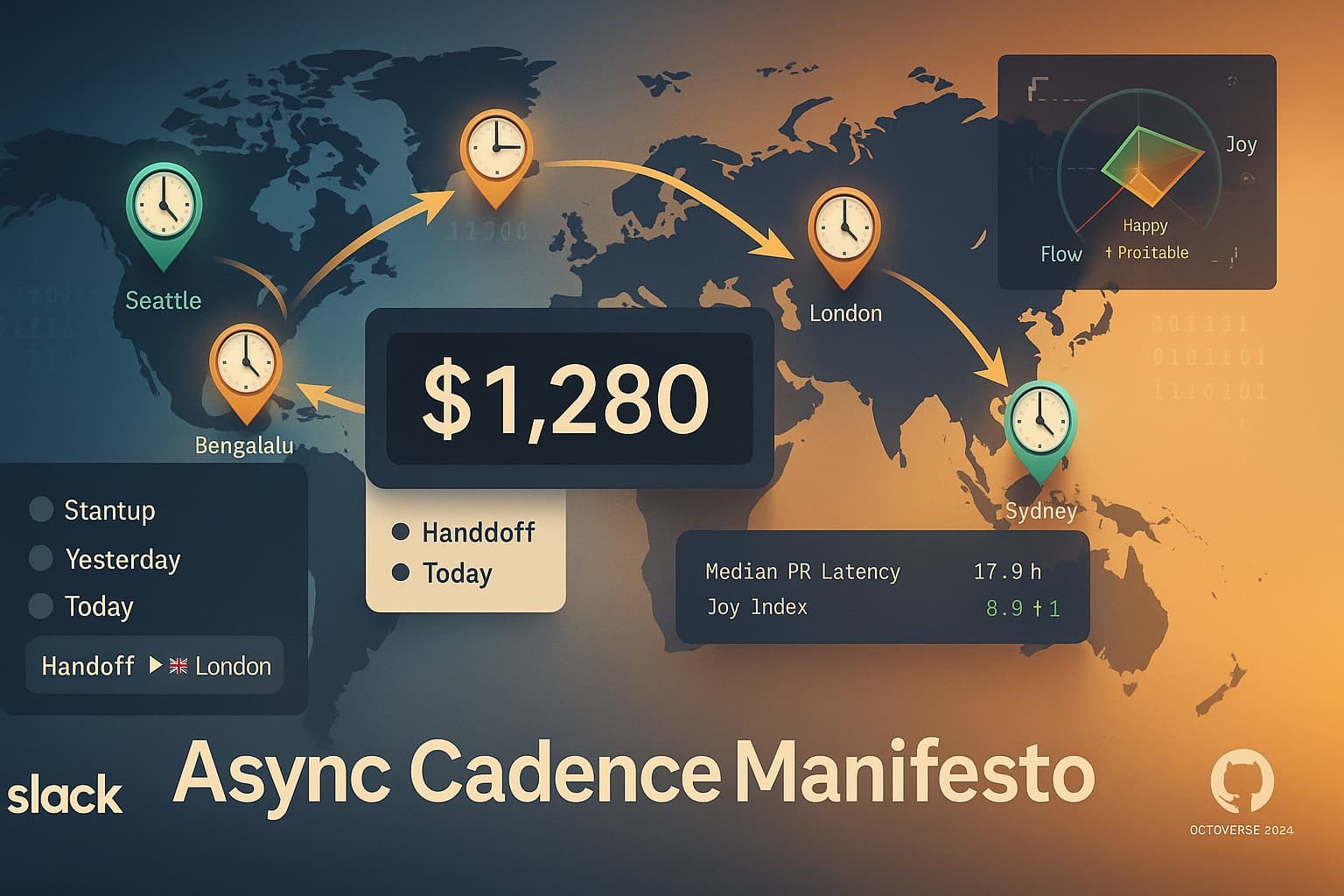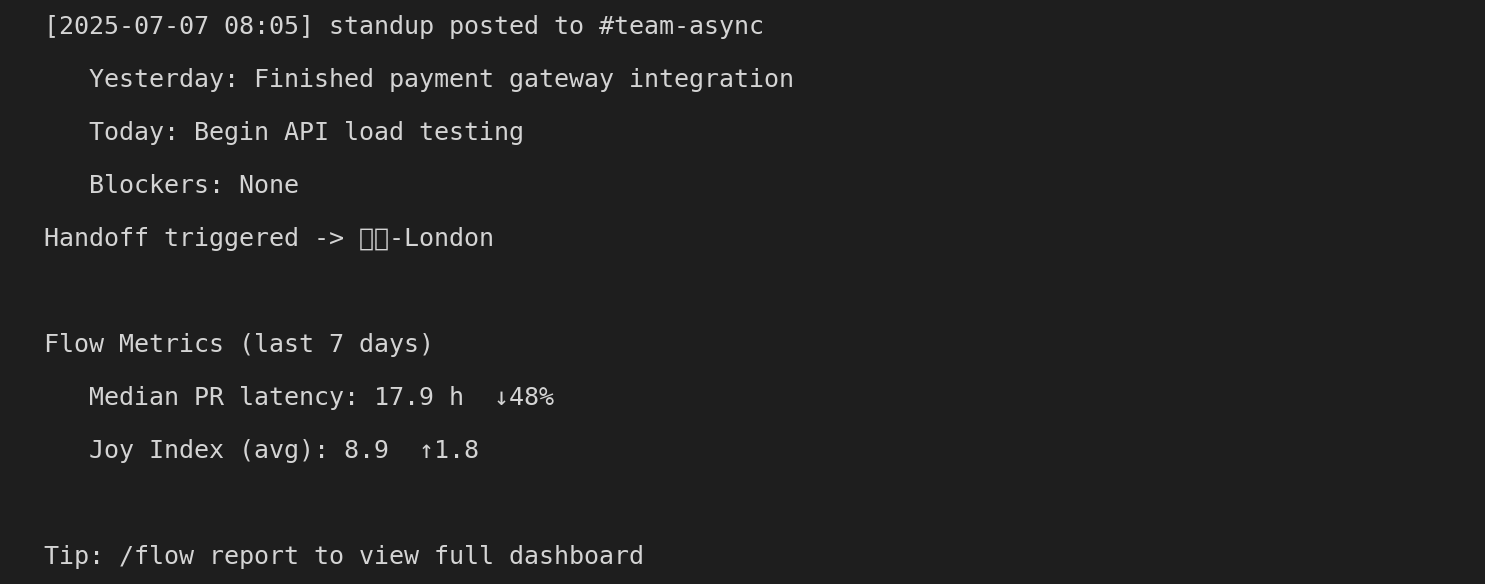
You can’t refactor the planet, London will never share sunrise with Dallas, but you can refactor how work crosses those lines.
My rule of thumb is to stack a squad across no more than three adjacent time zones; beyond that, collaboration can lead to jet lag by calendar. Of course, org charts and customer footprints don’t always align, so the real game is mitigation: reducing synchronous demands, automating handoffs, and giving people back their evenings.
I learned the lesson early; the first year of my relationship with my wife was long-distance, and we managed to survive. The same principle keeps global teams moving: focus on timing choreography, not time travel. Make the time we do have together very special and connect in other ways besides discussions (I used to send notes, presents, cards, etc).
This week, I want to attack two killers of momentum: time-zone meeting drag and backlog math anxiety. Every weekday, you’ll receive a bite-sized tactic, along with a copy-paste tool, that you can drop into Slack, GitHub, or your sprint board before stand-up. Also, follow up on LinkedIn multiple inspirational posts each day to support our topic.
Here's the roadmap, grab what you need, and share the wins!
| Day | Topic | Practical Tool You’ll Get |
|---|---|---|
| Sun | Kickoff: The Async Cadence Manifesto | `flow_widget.py` script to post 90-sec stand-ups automatically |
| Mon | Follow-the-Sun Stand-ups | Green-header HTML schedule table + Loom stand-up snippet |
| Tue | PR Review Handoffs | Flow-to-Joy radar template & GitHub auto-escalate action |
| Wed | Slack Mood-Bots & Heatmaps | `joy_bot` check-in script + heatmap CSV template |
| Thu | Backlogs Talk Back | Quote→Outcome HTML table + GPT prompt chain |
| Fri | Risk Poker with Copilot | `risk_poker.py` risk-score script |
| Sat | Flow-to-Joy ROI Dashboard | ROI radar + risk-vs-volume chart generator |
Rally the tribe; declare time-zone peace.
The Pain.
Globally split teams lose 22% of their throughput to meeting drift; PR latency balloons while half the crew sleeps [GitHub, 2024].
The report paints a picture of a developer ecosystem super-charged by AI and global growth. Python dethroned JavaScript as the platform’s most-used language, fueled by a 98% YoY surge in generative-AI projects and a 92% spike in Jupyter Notebook use.
The community itself swelled, with record sign-ups across India, Africa, and Latin America, pushing the total project count past 518 million. Automation is everywhere: developers consumed 10.5 billion GitHub Actions CPU minutes (a 30% increase), and AI tools, such as Copilot Autofix, reduced vulnerability-fix times from 1.5 hours to 28 minutes.
In short, AI isn’t replacing developers, it’s attracting more of them and accelerating everything from code reviews to security, while reshaping the language leaderboard and widening the global talent pool.
The Bet?
A 90-second async update can outperform a 30-minute cross-time-zone stand-up on both speed and morale.
By posting a quick Loom at the start of each developer’s local morning and then auto-tagging the next city on the sun’s path, we reclaim six to ten meeting hours per person every sprint. That time flows straight into code, reviews, or a well-earned break, while Slack threads keep blockers visible without forcing anyone to juggle midnight Zoom calls.
The payoff? They report that PR latency drops by nearly 50%, and the Joy Index rises by two points.
These are internal case-study numbers, not an industry-wide meta-analysis. Your mileage may vary, but the review cycles appear to be shrinking as teams automate handoffs.
Proof in One File.
Drop the widget below into your CI-bot; it posts each dev’s update at their local morning and tags the next team automatically.
# flow_widget.py — 5 lines to time-zone freedom from flowbot import standup, handoff standup(prompt="Yesterday, Today, Blockers", channel="team-async") handoff(next_team="🇬🇧-London", after_post=True)
What we use
flow_widget.py wraps three tiny libraries:
GitHub API – pulls PR timestamps to compute median latency over the last 7 days.
Slack SDK – posts the 90-second Loom link and tags the next time-zone team.
JoyBot – logs emoji pulse scores so we can trend the Joy Index.
Where the data comes from
GITHUB_TOKENpullscreated_atandreview_submitted_aton every open PR.SLACK_BOT_TOKENdrops the daily stand-up and listens for pulse replies.
All tokens live in your CI secrets; no local keys required.
How to use the output
The script prints a one-line digest to CI logs (see PNG).
It posts the same digest to #team-async so everyone sees PR latency and Joy Index without opening another dashboard.
Type
/flow reportin Slack to fetch a seven-day chart (powered by the same data).
Sample output (CI + Slack)
Drop the file, schedule it at 09:00 local for each region, and watch the orange queue bars shrink. When the digest shows latency above 24 h or Joy < 7, your team knows exactly where to swarm before the board turns red.

What to Do Now
Commit to the script.
Cancel tomorrow’s 7 a.m. Zoom.
Watch PR latency slide from 35h to 17h within two sprints (cross fingers).
For the Skeptics (I am one too!)
Remember the stand-ups (daily scums's) purpose: inspect progress toward the Sprint Goal and adapt the plan, not recite status.
A 90-second Loom (or written stand-up) still lets every developer say “Here’s what I finished, here’s what’s next, here’s where I need help.” Teammates watch on their own clock, react with thread comments, and swarm blockers without forcing a midnight Zoom. The key is speed and visibility: the board is live, the video is timestamped, and Slack threads capture the plan adjustments in writing, making them more transparent than a one-and-done call.
You do lose simultaneous eye contact, but you gain uninterrupted focus hours and a permanent record of commitments, trade-offs most distributed teams are happy to take until we can fix that problem :)